
 Home Home
 Season's Greetings! Season's Greetings!
 The Economic Crisis: The Economic Crisis:
A Dog's Perspective
 About Those Hounds... About Those Hounds...
 Our Hounds Our Hounds
 Adopting a Friend Adopting a Friend
 Adoption Application Adoption Application
 Rescue of the Month Rescue of the Month
 Special Rescues Special Rescues
 The Bagel Shoppe The Bagel Shoppe
 The Old Age Page The Old Age Page
 Black Listed Beauties Black Listed Beauties
 Getting Involved - Volunteering Getting Involved - Volunteering
 The Ugly Truth The Ugly Truth
 Success Stories Success Stories
 Wishlist Wishlist
 The Homewoods Herald The Homewoods Herald
 Houndware Houndware
 Memorials Memorials
 Muchas Gracias Muchas Gracias
 Contact Contact

 Pryor's Planet Pryor's Planet
 Ritchie Co. Humane Society Ritchie Co. Humane Society
 Humane Society of North Central West Virginia Humane Society of North Central West Virginia
 Whimsical Animal Rescue Whimsical Animal Rescue
|
|

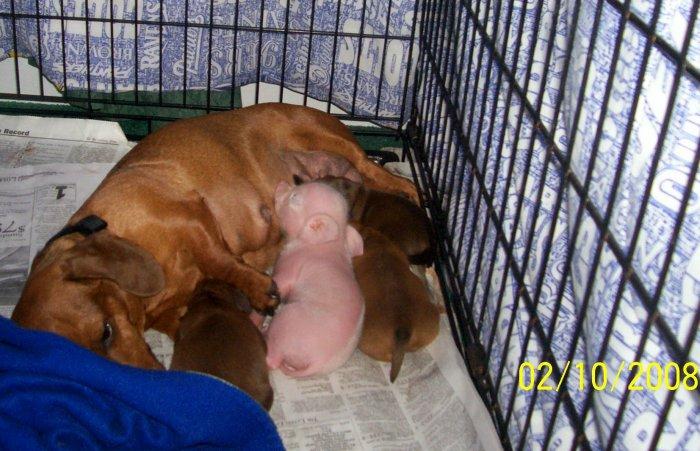
Mama Mia!
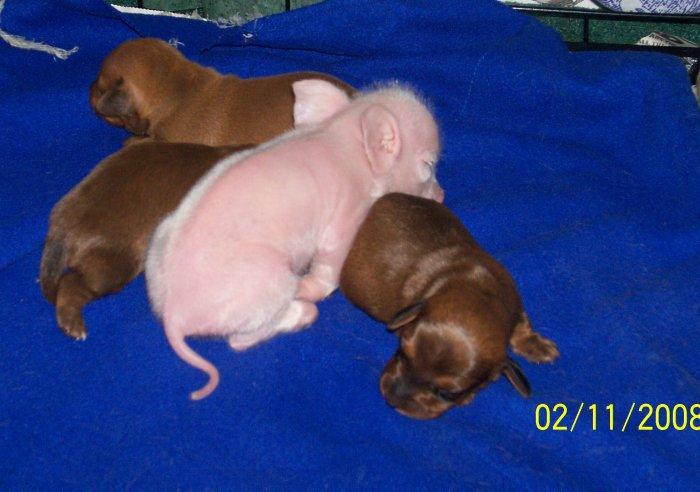
Homewoods Rescue wishes a Happy Mother's Day to moms of all kinds!
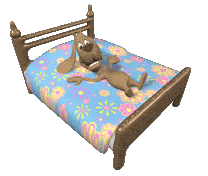 Let Sleeping Dogs Lie
Let Sleeping Dogs Lie
Whoever said, "LET SLEEPING DOGS LIE" didn't sleep with dogs. The first thing you discover when you bring a dog into your bed is the striking difference in weight between an alert, awake dog and a dog at rest.
Rule #1: The deeper the sleep the heavier the dog.
Most people who sleep with dogs develop spinal deformities rather than rent the heavy equipment necessary to move their snoring canines to a more appropriate part of the bed. Cunning canines steal precious space in tiny increments until they have achieved the center position on the bed, with all covers carefully tucked under them for safekeeping. The stretch and roll method is very effective in gaining territory. Less subtle tactics are sometimes preferred. A jealous dog can worm his way between a sleeping couple and, with the proper spring action from all four legs, shove a sleeping human to the floor.
Rule #2: The deeper the sleep the louder the dog.
As you cling to the edge of the bed, wishing you had covers, your sweet pup begins to snore at a volume you would not have thought possible. Once that quiets down, the dog dreams begin. Yipping, growling, running, kicking. Your bed becomes a battlefield and playground of canine fantasy. It starts out with a bit of "sleep running", lots of eye movement and then, suddenly, a shrieking howl blasted through the night like a banshee wail. The horror of this wake-up call haunts you for years. It's particularly devastating when your pup insists on sleeping curled around your head like a demented Daniel Boone cap.
Rule #3: When the dog wakes, you wake.
The night creeps on and you fall asleep in the 3 inches of bed not claimed by a dog. The dog dreams quiet slightly and the heap of dog flesh sleeps breathing heavily and passing wind. Then, too soon, its dawn and the heap stirs. Each dog has a distinctive and unpleasant method of waking the pack. One may position itself centimeters from a face and stare until you wake. The clever dog obtains excellent results by simply sneezing on your face, or they could romp all over your sleeping bodies, or the ever-loving insertion of a tongue in an unsuspecting ear.
So, why do we put up with this? There's no sane reason. Perhaps it's just that we're a pack and a pack heaps together at night safe, contented, heavy, and loud.

 Moving On: Remember Your Pets When Relocating Moving On: Remember Your Pets When Relocating
It's a tragic occurrence that's happening every day in America—families are being forced out of their homes when banks foreclose on their mortgages.
But just because a family loses its home doesn't mean that the family pet must lose both his home and his family.
With a foreclosure crisis sweeping the nation, The Humane Society of the United States (HSUS) is disturbed by reports that some residents forced out of their homes are simply leaving their pets behind.
HR urges all pet owners faced with foreclosure to take their pets with them when they relocate.
Abandoning pets, for any reason, is not only irresponsible—it is illegal .
Pet owners may feel financially unable to care for their pets or are overwhelmed by a sudden move, but there are many alternatives to leaving pets behind. For those in need of help, we offer tips on easing the financial burden of pet ownership and finding pet-friendly housing.
No Future
Abandoned pets face a grim future. Many pets trapped inside abandoned homes aren't found until they're on the brink of starvation. Those lucky enough to reach a shelter or rescue have about a 50 percent chance of being adopted.
No one likes to think of leaving their pet at a shelter, but if you can't take him with you, it is by far more humane than leaving them in an apartment or a house alone . Too many animals die alone this way every year. If people are absolutely unable to care for their pet any longer, they should take him or her to their local animal shelter or animal control agency or rescue. The shelter can provide food and housing while they try and locate a new home.
Plan Ahead
These outcomes can be avoided by planning ahead as much as possible and finding pet-friendly housing. The following steps can help in the search for pet-friendly rental housing:
• Give yourself enough time. If possible, check ads and contact real estate agents and rental agencies at least six weeks before you plan to move or when you first learn that foreclosure and/or eviction may be in your future.
• Make use of available resources. Contact the humane society or animal care and control agency serving the area into which you are moving; the agency may be able to provide you with a list of apartment communities that allow pets.
• Gather proof that you're responsible. The more documentation you can provide attesting to your conscientiousness as a pet owner, the more convincing your appeal will be to your future landlord. This can include statements from current property managers and neighbors that you maintain your pet responsibly, as well as copies of veterinary records showing ongoing pet care.
• Get it in writing. Once you have permission from a landlord, manager or condominium committee to have a pet, be sure to get it in writing. Comprehensive agreements protect people, property and the pets themselves.
Cutting Costs
Individuals facing financial hardships can reduce the cost of pet ownership in many ways. Some tips include:
• While buying expensive toys and accessories has become a popular way to demonstrate your attachment to your pet, your pet can be just as happy with less expensive toys or homemade toys. They need your love and attention more than a pricey product. The HSUS has tips for inexpensive toys for both cats and dogs.
• Keep your pets safe inside or on a leash while walking outside. Animals allowed to roam freely are more prone to accidents and resulting veterinary bills.
• Let your veterinarian know that finances are tight and ask that he or she prescribe only the most vital vaccinations to keep your pet healthy.
• Consider pet health insurance to minimize the shock of an expensive bill from the veterinarian in case of an unexpected illness or injury.
THE NOSE KNOWS
Dogs Today Can Make a Living Sniffing Out Just About Anything
PET CONNECTION by Dr. Marty Becker and Gina Spadafori
Universal Press Syndicate
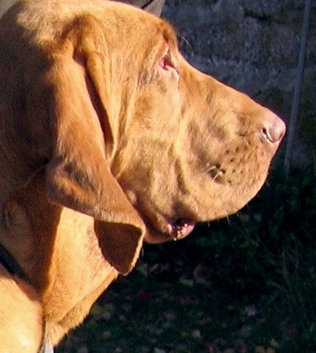 Is there anything a dog can't use his nose to figure out? Dogs have long been used to sniff out escaped cons and missing children (think bloodhounds), dinner (think spaniels, retrievers and hounds), and even truffles (think poodles). Is there anything a dog can't use his nose to figure out? Dogs have long been used to sniff out escaped cons and missing children (think bloodhounds), dinner (think spaniels, retrievers and hounds), and even truffles (think poodles).
But in recent years, trainers have come up with all kinds of new ways to use a dog's extraordinary sense of smell. Here are a few you maybe knew -- and a few more we bet you did not:
· Drugs. Dogs can be trained to sniff out all kinds of illegal drugs, finding them not only on people but also in massive cargo containers, long-haul trucks and school lockers.
· Plant matter. Since fresh fruits and vegetables can bring insects and diseases into the country that have the potential to cause great damage to agriculture, dogs are used to detect the foodstuffs in the luggage of people coming through customs. Dogs are also used to sniff out invasive weeds in fields, so the plants can be eradicated before they take hold.
· Insects. Termites? No problem. Dogs are also being used to detect the resurgence of bedbugs in big cities.
· Mold. It's not just the mold that bedevils homeowners, but also the mold that puts the vines at wineries at risk from the spread of disease.
· Explosives. Meetings of high public officials would be hard to imagine without the diligent work of bomb-sniffing dogs. To take it a bit further, dogs are even being taught to sniff out cell phones that could be used to detonate a bomb.
· Cows in heat. A lot of money depends on being able to artificially inseminate a cow without wasting time guessing when she's ready. While a bull could tell, he's not always available, as his contribution usually arrives on the scene frozen. A dog can tell when the cow is most fertile -- although it's a good bet the dog couldn't care less.
· Cancer. While cancer-detection is still in the trial stage, it's looking pretty promising that dogs can spot a malignancy. Some day your doctor may order up a "lab test" and mean Labrador!
· Chemicals. Dogs have been known to look for items as varied as mercury and the components of potentially pirated DVDs.
While most of us tend to think scent work is the near-exclusive province of a handful of breeds -- bloodhounds, German shepherds and maybe a Labrador retriever here and there -- in fact, a wide range of breeds and mixes is trained to detect various scents. Because of their fine noses and friendly dispositions, beagles are used to work airports by the U.S. Department of Agriculture, and any manner of mixed breeds -- lucky dogs pulled from shelters -- have been used for other kinds of detection work.
Because all dogs have keen noses filled with many more scent receptors than we humans have, a dog's future doing nose work relies more on enthusiasm, reliability and trainability than on the canine common ability to tell one scent from another.
WRINKLES FOR A REASON
Humans have about 5 million scent receptors in their noses; dogs have about 200 million. Dogs can detect tiny levels of odors, even a few parts per billion. Their noses are also uniquely designed to draw air samples through -- for the most part.
You're not going to see a dog with a pushed-in muzzle, like a pug, tracking someone on "America's Most Wanted." That's because when breeding for a short nose -- and a face more like ours -- we've reduced the real estate available for scent receptors in these breeds.
On the other end of the scale, a dog developed for tracking, such as the bloodhound, has a sense of smell so keen, the results of his work are admissible in a court of law. In addition to a long, deep muzzle, the bloodhound has ears to sweep scent from the ground and skin folds to hold scents around the face. -- Dr. Marty Becker

Disaster Action Guidelines for Dog and Cat Owners
 In the event of a natural or manmade disaster, pets are not allowed inside emergency shelters for humans due to public health and safety reasons. If you and your family need to evacuate to a public shelter during a disaster, you must have planned in advance for the care of your dog or cat. Such planning could save your pet’s life and make yours easier. In the event of a natural or manmade disaster, pets are not allowed inside emergency shelters for humans due to public health and safety reasons. If you and your family need to evacuate to a public shelter during a disaster, you must have planned in advance for the care of your dog or cat. Such planning could save your pet’s life and make yours easier.
Plan Ahead Before a Disaster Occurs:
- Acquire a steel or fiberglass pet carrier (portable kennel) or crate for each pet. Carriers should be large enough for the pet to stand up and turn around.
- Familiarize your pet with the carrier.
- Be sure your pet’s vaccinations and medical records are written and up-to-date. Most boarding facilities require proof of current rabies and distemper vaccinations. Also, have documentation of any medicines with dosing instructions and name and phone number of the veterinarian who dispensed the drugs.
- Be sure your pet wears a properly fitted collar with a current license tag, rabies tag and identification tag displaying your name, animal’s name, address and phone number. Also, provide an alternate identification tag with the name, address and phone number of a relative in a different area who could be contacted if you cannot. Consider permanent identification of your pet with a national registry using either a tattoo or a microchip implant.
- Acquire a leash to have on hand to maintain control of your pet.
- Survey your home and determine the best location away from windows if possible to place your pet during an emergency - utility room, bathroom, kitchen or other tiled room which can be cleaned easily.
- Decide on where you might take your pet if it becomes necessary to leave your home during an emergency. Places you could contact are:
- Boarding kennels
- Veterinary hospitals with boarding facilities
- Friends or relatives
- Motels where you can stay if they will allow pets
- Acquire non-spill water and food bowls.
- Consult your veterinarian on what to do if your pet is on a special diet or needs motion sickness or other medications.
- Stock up on pet food (dry type that is relatively unpalatable to prevent overeating) and kitty litter for emergency use.
- Stock up on newspapers, plastic bags, cleanser and disinfectants to properly handle pet wastes.
At the Time of Disaster:
- Listen to the emergency broadcasting station on your portable radio for information on how to locate pet care providers offering services during the disaster.
- If you plan to leave your home and must leave your pet behind, remember:
- Bring your pet indoors. Do not leave your pet tied up outside.
- Prepare and clean the reselected site in the house.
- Leave only dry type foods. Use sturdy food containers.
- Do not leave any treat type vitamins and mineral supplements. Overeating these may cause poisoning if too much is consumed.
- Water for pets should be left in bathtubs or other sturdy spill-proof containers. Leave toilet seats up. Flush toilet before leaving.
- Never leave a cat with a dog even if the two are normally friendly! Keep small pets such as birds and hamsters away from dogs and cats. Put difficult or dangerous animals in sturdy crates or cages to reduce the possibility of them getting loose.
- Take your pet’s immunizations and health records with you because records left at home may be damaged during the disaster.
- If you must evacuate your home and plan to take your pet to a boarding facility, motel or a friend or relative’s house, take them all the items you have acquired before the disaster including food, non-spill food and water containers, medications and your pet’s health and vaccination records.
After the Disaster:
- Be careful allowing your pet outdoors after the disaster. Familiar scents and landmarks may be altered and your poet could easily become confused and become lost. Downed power lines and raccoons, skunks or other wild animals that may have entered the area could present a real disaster to your pet.
- Of your pet is lost during the disaster, contact veterinary hospitals, boarding kennels, animal control facilities and humane societies in your area. Also call the national lost pet hotline (1-900-535-1515) to report your loss. (This is a toll call.)
- If you find your pet, contact your local humane society, any phone numbers that may have been set up during the disaster to report lost or found animals or the national found pet hotline (1-800-755-8111).
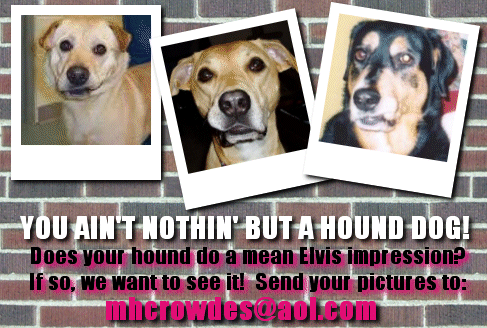
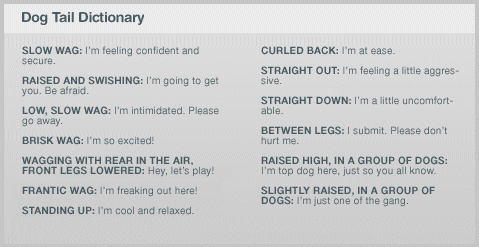
Pryor's Planet
As many of you know, Jennifer and Richard Pryor have been very good friends and supporters of HOMEWOODS RESCUE. We, as most of you, have been touched by Richard and his unbelievable comedy throughout our lives and are saddened by his passing – he will be greatly missed.
Most people do not know that Richard was an outspoken advocate for compassion and humane treatment of animals. We are grateful to the Pryors for their support and want to help them as they have helped us.
In lieu of flowers, Jennifer has requested that donations be made to their charity Pryor’s Planet: A Saving Grace for all Animals. Richard’s love of animals and his fight against injustices went hand in hand.
Won't you help in this great endeavor? Thank you!
Marth Crowdes
Local Beagle Makes the Big Time
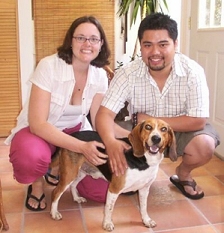 Once upon a time, there was a beautiful dashing beagle who, through no
fault of his own, found himself homeless and ended up at Homewoods Rescue.
Marth named him "Wishbone" because he told her his greatest wish was to get
a home. Wishbone remained at HR for quite a while, but he never lost his
spirit or his self esteem because he had always known he had movie-star good
looks and a charming personality. Once upon a time, there was a beautiful dashing beagle who, through no
fault of his own, found himself homeless and ended up at Homewoods Rescue.
Marth named him "Wishbone" because he told her his greatest wish was to get
a home. Wishbone remained at HR for quite a while, but he never lost his
spirit or his self esteem because he had always known he had movie-star good
looks and a charming personality.
One day a nice young couple from NYC found Wishbone's photo and story on
petfinder.com. They called HR and told Marth they wanted to adopt a hound but
were put off by the negative (and undeserved) propaganda about hounds not
making good pets. Marth assured them that Wishbone was as sweet, well
adjusted, mannerly, and good-looking as his picture and story suggested. As they
prepared to make the long trek down to Bivalve MD to get Wishbone, they had
but one request of Marth. They asked if they could change Wishbone's name to
"Naked", so they could say "Let's go get Naked." Marth asked Wishbone
whether he would mind, but Wishbone, who had paraded around in his birthday
suit his entire life and knew how gorgeous he was, was all for it.
The nice young couple fell instantly in love with Naked's charm and good
looks, and so did a lot of other people. The ASPCA features a different
adopted pet for each month on its calendar, and Naked was chosen as the
December story on the ASPCA's 2006 Calendar.
When asked for comment, Naked said he was not surprised as he has
always known how gorgeous and lovable he is. His goal is to be the "Naked"
centerfold for Playgirl Magazine, and he says he might consider films if the
money is right. But for now he is content to dote on his loving owners, to
be the center of their universe, and to be the Spokespup for beagles. Naked
says: "As a breed, we beagles are generally all good looking, fun-loving,
sweet-tempered, cuddly, good with kids and other animals, and easy going. And if
you don't believe me, take a look at Norman Rockwell's pictures!" And that's
the naked truth!!!!!
MORAL OF THE STORY: ADOPT A BEAGLE BUNDLE OF LOVE! HERE AT HR, WE HAVE A
WONDERFUL SELECTION OF THESE LOVABLE, SNUGGLY LITTLE PETS WHO ARE WAITING
PATIENTLY FOR THE SAME KIND OF WONDERFUL HOME THAT NAKED GOT.
An Open Letter to My Pets
Dear Dogs and Cats,
The dishes with the paw print are yours and contain your food. The other dishes are mine and contain my food. Please note, placing a paw print in the middle of my plate and food does not stake a claim for it becoming your food and dish, nor do I find that aesthetically pleasing in the slightest.
The stairway was not designed by NASCAR and is not a racetrack. Beating me to the bottom is not the object. Tripping me doesn't help because I fall faster than you can run.
I cannot buy anything bigger than a king sized bed. I am very sorry about this. Do not think I will continue sleeping on the couch to ensure your comfort. Dogs and cats can actually curl up in a ball when they sleep. It is not necessary to sleep perpendicular to each other stretched out to the fullest extent possible. I also know that sticking tails straight out and having tongues hanging out the other end to maximize space is nothing but sarcasm.
For the last time, there is not a secret exit from the bathroom. If by some miracle I beat you there and manage to get the door shut, it is not necessary to claw, whine, meow, try to turn the knob or get your paw under the edge and try to pull the door open. I must exit through the same door I entered. Also, I have been using the bathroom for years --canine or feline attendance is not mandatory.
The proper order is kiss me, then go smell the other dog or cat's butt. I cannot stress this enough!
To pacify you, my dear pets, I have posted the following message on our front door:
All Non-Pet Owners Who Visit & Like to Complain About Our Pets
- They live here. You don't.
- If you don't want their hair on your clothes, stay off the furniture. (That's why they call it "fur"niture.)
- I like my pets a lot better than I like most people.
- To you, it's an animal. To me, he/she is an adopted son/daughter who is short, hairy, walks on all fours and doesn't speak clearly.
Remember: Dogs and cats are better than kids because they:
- Eat less
- Don't ask for money all the time
- Are easier to train
- Usually come when called
- Never drive your car
- Don't hang out with drug-using friends
- Don't smoke or drink
- Don't worry about having to buy the latest fashions
- Don't wear your clothes
- Don't need a gazillion dollars for college, and
- If they get pregnant, you can sell their children
A Young Dog Teaches an Old Dog New Tricks
By David Feherty
It was one of those spur-of-the-moment impulse buys that usually turns out disastrous. From a squirming cluster of beagle puppies in a roadside wire cage, tended by a nasty looking hillbilly with a wooden pickup truck, four teeth and a lousy attitude, I paid 350 bucks for the littlest one, a pitiful runt with a broken tail. He was no bigger than a hamster, weighing in at less than a pound, and when She Who Must Be Obeyed finally stopped yelling at me, we learned from our vet that the feeble wee grub was from a puppy mill in Oklahoma, chemically dependent and completely incontinent. Hey, I'm not from Oklahoma, but already we had a couple of things in common! We named him Ziggy, and I knew I would love this dog like no other.
We'd never had a beagle before, but we were prepared for psychotic chewing and howling trauma. Our resident house-hound, Willard the Wonder Mutt, was positively dog-smacked about the new arrival. He thought this was great, something that he could hump around the den, but once young Zigmoid got a little strength, the student-houndling became the master and--who's your daddy!--the humper became the humpee.
As far as I can tell, a beagle's human exists only to provide too much food and the kind of vigorous arse and back-scratching that a beagle deserves simply because he's a beagle. If Ziggy goes missing in the house, there's an odds-on chance he's buried in the most expensive throw pillow, and not before he's given it a horrible trampling. If I drop an M&M anywhere in the house, Ziggy will find it within 45 seconds, and I swear if the rest of the packet were hidden in the house next door, he'd spend the night tunneling through hardwood floors and four feet of concrete slab to get at it, pausing only to kill several squirrels and bang the crap out of an apparently dead posum. Hey, if it's still warm...
I adore this dog, whose life's mission it is to be at the center of mine. He's under my feet, in my bed, on my lap in the car and down my throat after dinner. I used to be able to blame the occasional sly air-biscuit on old Willard, but now Ziggy heads straight for the source at the seat of my pants. He's up my arse like a DustBuster. He's like a tricolored scratch 'n' sniff lie detector. If I had two of them, they might meet at my pancreas. But the thing I admire most about the little prince is that, in his own mind, he is obviously the highest form of intelligence on the planet, and yet he carries himself with the sweet humility and groveling gratitude that only a dog can possess. In any other creature, such behavior would be revolting.
And Willard, the simple wiener-schnauzer-gerbil-hound who used to be top dog, has been transformed from the Wonder Mutt into the Mutt That Wonders. I dole out chew sticks, one apiece, and Ziggy calmly takes his and buries it in a houseplant, underneath a sofa cushion, or in the suitcase that lies half-packed most of the time on my dressing-room floor. (Finding a slimy piece of rawhide in your underpants is a real beagle bonus in a hotel room.) Then he returns to the underdog, and with the efficiency of a turbo-charged wood chipper, he eats Willard's treat. Then he goes back to the houseplant, retrieves his own, and eats it too. Willard is completely unperturbed, but then one of the reasons dogs are better than humans is because the losers among them are happy to follow.
My life is weird. I have a late flight here, a bad flight there. Here a prop, there a jet. Occasionally a bed wet, and waaay too often, old McDonalds for dinner. It's hard to find anything consistent on the road, but I do know this: When I stumble in at 1 a.m. on a Monday from Memphis, or Detroit, or Milwaukee, or wherever, even if I'm still wearing golf shoes and plastered with sunscreen and stale sweat, there will assuredly be frantically wiggling bodies at the back door. Willard will try to lick me into a coma, and after Ziggy has rooted through my suitcase to make sure there isn't some rotten pig's ear he's forgotten, this 28 pounds of anointed hound will allow me the privelege of scratching every square inch of him before he burrows his way under the sheets and molds himself into the crook of She Who Must Be Obeyed's legs.
Yes, we adore this dog, but then again, as he constantly reminds us, we're only human.
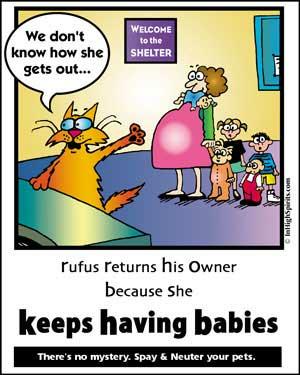

|

